高中英语教学案例
信息技术融合创新应用成果——高中英语教学案例《乌鸦喝水》
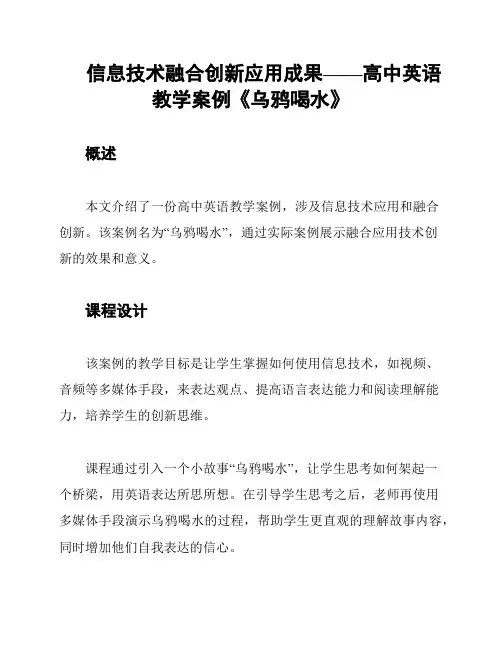
信息技术融合创新应用成果——高中英语
教学案例《乌鸦喝水》
概述
本文介绍了一份高中英语教学案例,涉及信息技术应用和融合
创新。
该案例名为“乌鸦喝水”,通过实际案例展示融合应用技术创
新的效果和意义。
课程设计
该案例的教学目标是让学生掌握如何使用信息技术,如视频、
音频等多媒体手段,来表达观点、提高语言表达能力和阅读理解能力,培养学生的创新思维。
课程通过引入一个小故事“乌鸦喝水”,让学生思考如何架起一
个桥梁,用英语表达所思所想。
在引导学生思考之后,老师再使用
多媒体手段演示乌鸦喝水的过程,帮助学生更直观的理解故事内容,同时增加他们自我表达的信心。
教学成效
通过这样的方式教学,学生的听说读写能力都得到较好的提高,同时开拓了学生的视野,让他们知晓如何运用信息技术来进行语言
表达。
结论
信息技术的应用已经深入到我们的生活之中,教育领域也不例外。
通过本案例,我们可以看到融合应用信息技术所带来的优势,
已经成为教学的趋势和未来发展方向。
高中英语教师教学案例分析范文6篇
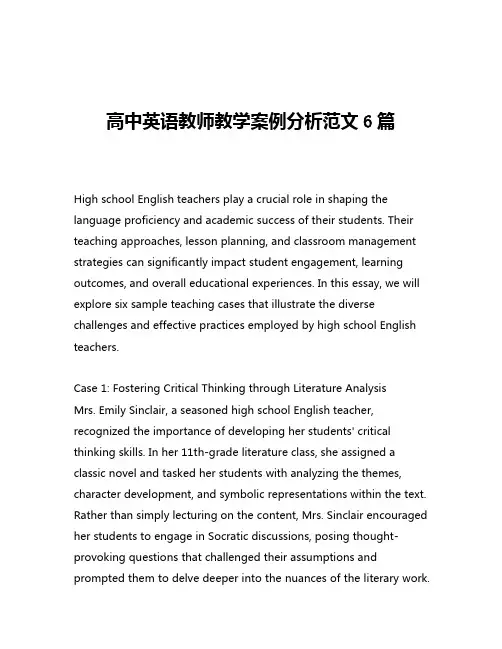
高中英语教师教学案例分析范文6篇High school English teachers play a crucial role in shaping the language proficiency and academic success of their students. Their teaching approaches, lesson planning, and classroom management strategies can significantly impact student engagement, learning outcomes, and overall educational experiences. In this essay, we will explore six sample teaching cases that illustrate the diverse challenges and effective practices employed by high school English teachers.Case 1: Fostering Critical Thinking through Literature AnalysisMrs. Emily Sinclair, a seasoned high school English teacher, recognized the importance of developing her students' critical thinking skills. In her 11th-grade literature class, she assigned a classic novel and tasked her students with analyzing the themes, character development, and symbolic representations within the text. Rather than simply lecturing on the content, Mrs. Sinclair encouraged her students to engage in Socratic discussions, posing thought-provoking questions that challenged their assumptions and prompted them to delve deeper into the nuances of the literary work.By guiding her students through close textual analysis and collaborative discussions, Mrs. Sinclair empowered them to form their own interpretations and defend their perspectives with evidence from the text. This approach not only enhanced the students' critical thinking abilities but also fostered a greater appreciation for literature and its ability to explore complex human experiences.Case 2: Integrating Technology to Enhance Vocabulary Instruction Mr. Liam Fitzgerald, a tech-savvy high school English teacher, understood the importance of adapting his teaching methods to the digital age. In his 10th-grade English class, he incorporated various technological tools to enhance vocabulary instruction. Instead of relying solely on traditional flashcards or memorization exercises, Mr. Fitzgerald utilized interactive vocabulary-building software that allowed students to engage with new words through visual aids, word games, and contextual learning activities. Additionally, he encouraged his students to create digital vocabulary portfolios, where they could curate their own word collections, analyze word roots and etymologies, and demonstrate their understanding through multimedia presentations. By seamlessly integrating technology into his vocabulary lessons, Mr. Fitzgerald was able to capture the attention of his tech-savvy students, promote active engagement, and ultimately improve their retention and application of new vocabulary.Case 3: Differentiated Instruction for Diverse LearnersMs. Olivia Hernandez, a dedicated high school English teacher, recognized the importance of addressing the diverse learning needs of her students. In her 9th-grade English class, she implemented a differentiated instructional approach, tailoring her lessons and activities to cater to students with varying abilities, learning styles, and language proficiency levels. For instance, she provided audio recordings of texts for students who preferred to learn through listening, while offering graphic organizers and visual aids for those who thrived on visual learning. Additionally, she offered tiered assignments that allowed students to demonstrate their understanding at different levels of complexity, ensuring that all learners could experience success and progress at their own pace. By adopting a differentiated approach, Ms. Hernandez was able to create a more inclusive and supportive learning environment, where each student felt empowered to engage with the material and develop their English language skills.Case 4: Cultivating Creativity through Narrative WritingMr. Ethan Nguyen, a passionate high school English teacher, believed in the transformative power of creative writing. In his 12th-grade English class, he dedicated a significant portion of the curriculum to narrative writing, encouraging his students to explore their personal experiences, imagination, and unique perspectives. Rather thanprescribing rigid writing prompts, Mr. Nguyen allowed his students to choose their own topics and experiment with different narrative techniques, such as character development, dialogue, and descriptive language. He provided constructive feedback and facilitated peer-review sessions, where students could learn from each other's strengths and offer suggestions for improvement. By fostering a supportive and collaborative environment, Mr. Nguyen inspired his students to embrace their creativity, develop their voice as writers, and discover the joy of storytelling.Case 5: Integrating Cross-Curricular Connections in English InstructionMs. Sophia Patel, a versatile high school English teacher, recognized the value of integrating cross-curricular connections into her lessons. In her 11th-grade English class, she collaborated with the history and science departments to design interdisciplinary units that explored the intersections between literature, historical events, and scientific concepts. For instance, when studying a novel set during the Civil War era, Ms. Patel incorporated primary source documents, historical analyses, and discussions of the sociopolitical context to provide a more comprehensive understanding of the literary work. Similarly, when examining a work of science fiction, she engaged her students in discussions about the scientific principles and technological advancements that inspired the narrative. By fostering these cross-curricular connections, Ms. Patel helped her students appreciate therelevance and application of English skills across different academic disciplines, ultimately enhancing their overall learning experience.Case 6: Fostering Effective Communication through Oral PresentationsMr. Liam Fitzgerald, a skilled high school English teacher, understood the importance of developing his students' oral communication skills. In his 12th-grade English class, he regularly incorporated oral presentation assignments, where students were required to research, organize, and deliver informative or persuasive speeches on a variety of topics. To support his students' development, Mr. Fitzgerald provided detailed rubrics, offered feedback on their presentation skills, and encouraged peer evaluation. He also incorporated opportunities for students to practice their public speaking skills through structured class discussions, Socratic seminars, and debate-style activities. By emphasizing the importance of effective communication, Mr. Fitzgerald not only helped his students improve their English language proficiency but also equipped them with valuable life skills that would serve them well in their future academic and professional endeavors.These six sample teaching cases illustrate the diverse approaches and strategies employed by high school English teachers to enhance student learning, foster critical thinking, and develop essential language skills. From leveraging technology to promote vocabularyacquisition to cultivating creativity through narrative writing, these teachers have demonstrated their commitment to adapting their instructional practices to the needs and interests of their students. By sharing these exemplary teaching cases, we can inspire other educators to explore innovative methods, embrace cross-curricular connections, and prioritize the holistic development of their students in the high school English classroom.。
高中英语教学案例分析
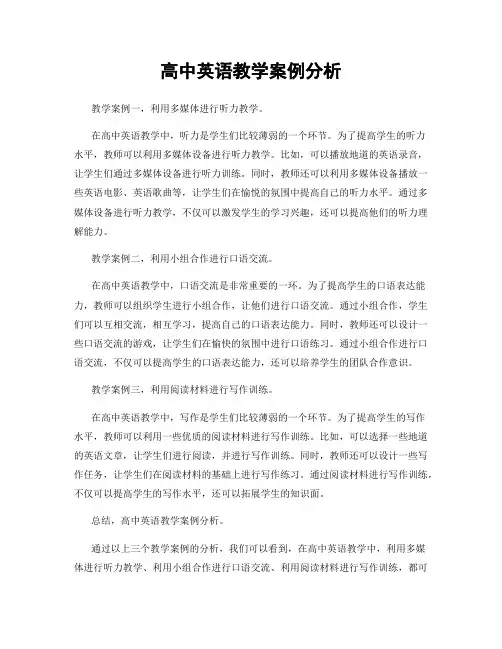
高中英语教学案例分析教学案例一,利用多媒体进行听力教学。
在高中英语教学中,听力是学生们比较薄弱的一个环节。
为了提高学生的听力水平,教师可以利用多媒体设备进行听力教学。
比如,可以播放地道的英语录音,让学生们通过多媒体设备进行听力训练。
同时,教师还可以利用多媒体设备播放一些英语电影、英语歌曲等,让学生们在愉悦的氛围中提高自己的听力水平。
通过多媒体设备进行听力教学,不仅可以激发学生的学习兴趣,还可以提高他们的听力理解能力。
教学案例二,利用小组合作进行口语交流。
在高中英语教学中,口语交流是非常重要的一环。
为了提高学生的口语表达能力,教师可以组织学生进行小组合作,让他们进行口语交流。
通过小组合作,学生们可以互相交流,相互学习,提高自己的口语表达能力。
同时,教师还可以设计一些口语交流的游戏,让学生们在愉快的氛围中进行口语练习。
通过小组合作进行口语交流,不仅可以提高学生的口语表达能力,还可以培养学生的团队合作意识。
教学案例三,利用阅读材料进行写作训练。
在高中英语教学中,写作是学生们比较薄弱的一个环节。
为了提高学生的写作水平,教师可以利用一些优质的阅读材料进行写作训练。
比如,可以选择一些地道的英语文章,让学生们进行阅读,并进行写作训练。
同时,教师还可以设计一些写作任务,让学生们在阅读材料的基础上进行写作练习。
通过阅读材料进行写作训练,不仅可以提高学生的写作水平,还可以拓展学生的知识面。
总结,高中英语教学案例分析。
通过以上三个教学案例的分析,我们可以看到,在高中英语教学中,利用多媒体进行听力教学、利用小组合作进行口语交流、利用阅读材料进行写作训练,都可以有效地提高学生的英语学习水平。
因此,教师们在教学中可以根据学生的实际情况,灵活运用这些教学案例,从而更好地促进学生的英语学习。
希望以上案例可以为广大英语教师提供一些借鉴和启发,让我们共同努力,为学生的英语学习创造更好的教学环境。
信息技术融合创新应用成果——高中英语教学案例《乌鸦喝水》
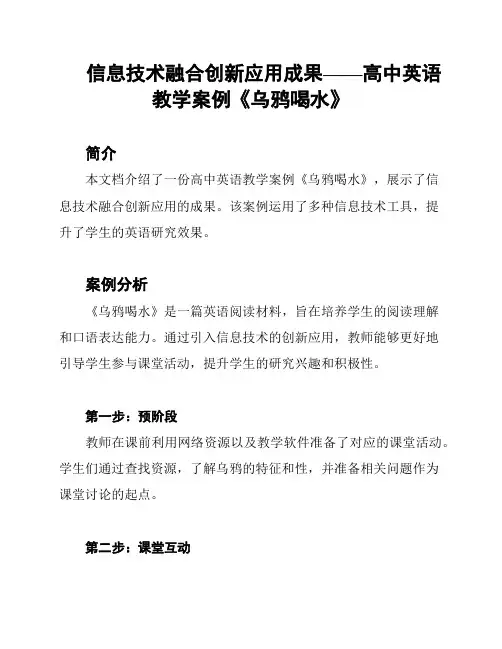
信息技术融合创新应用成果——高中英语教学案例《乌鸦喝水》简介本文档介绍了一份高中英语教学案例《乌鸦喝水》,展示了信息技术融合创新应用的成果。
该案例运用了多种信息技术工具,提升了学生的英语研究效果。
案例分析《乌鸦喝水》是一篇英语阅读材料,旨在培养学生的阅读理解和口语表达能力。
通过引入信息技术的创新应用,教师能够更好地引导学生参与课堂活动,提升学生的研究兴趣和积极性。
第一步:预阶段教师在课前利用网络资源以及教学软件准备了对应的课堂活动。
学生们通过查找资源,了解乌鸦的特征和性,并准备相关问题作为课堂讨论的起点。
第二步:课堂互动教师首先通过使用互动白板软件将阅读材料展示给学生。
学生们在听读材料的同时,教师利用投影仪展示与乌鸦相关的图片和视频,激发学生对乌鸦的兴趣。
学生们可以用语言或者软件工具标注材料中的重点内容。
第三步:小组合作学生分成小组,利用笔记本电脑或平板电脑进行小组合作。
他们可以使用电子白板软件共同编辑并呈现他们对乌鸦喝水故事的理解和表达。
学生们可以互相讨论、修改和完善自己的作品。
第四步:展示和分享每个小组派代表呈现他们的作品给全班同学。
学生们可以通过投影仪将自己编辑的内容展示给全班,以及分享他们在小组合作中的收获和思考。
效果评估通过引入信息技术融合创新应用,学生们的研究效果得到了显著提升。
他们在阅读理解和口语表达方面取得了进步,且能够灵活运用信息技术工具进行合作与展示。
教师在课堂上的角色也得到了转变,从传统的知识传授者转变为学生研究的指导者和引导者。
结论《乌鸦喝水》这个案例充分展示了信息技术融合创新应用在高中英语教学中的成果。
通过充分利用多种信息技术工具,教师能够提升教学效果,激发学生的学习兴趣和积极性,培养学生的综合能力。
这个案例可以为其他教师在英语教学中运用信息技术提供借鉴和启示。
高中英语教学设计优秀7篇
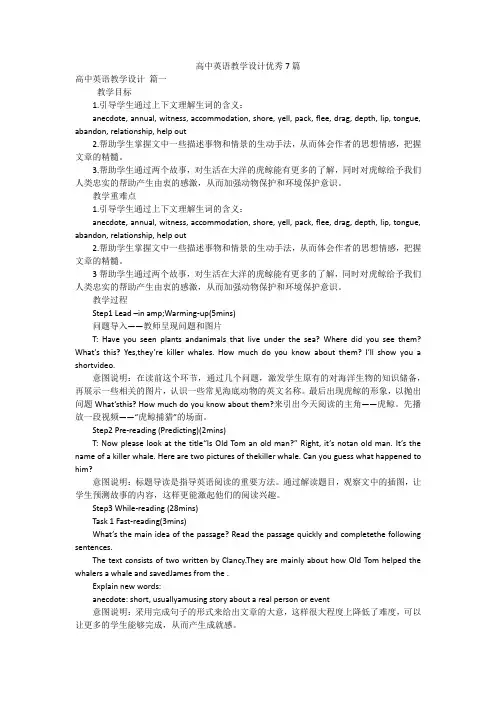
高中英语教学设计优秀7篇高中英语教学设计篇一教学目标1.引导学生通过上下文理解生词的含义:anecdote, annual, witness, accommodation, shore, yell, pack, flee, drag, depth, lip, tongue, abandon, relationship, help out2.帮助学生掌握文中一些描述事物和情景的生动手法,从而体会作者的思想情感,把握文章的精髓。
3.帮助学生通过两个故事,对生活在大洋的虎鲸能有更多的了解,同时对虎鲸给予我们人类忠实的帮助产生由衷的感激,从而加强动物保护和环境保护意识。
教学重难点1.引导学生通过上下文理解生词的含义:anecdote, annual, witness, accommodation, shore, yell, pack, flee, drag, depth, lip, tongue, abandon, relationship, help out2.帮助学生掌握文中一些描述事物和情景的生动手法,从而体会作者的思想情感,把握文章的精髓。
3帮助学生通过两个故事,对生活在大洋的虎鲸能有更多的了解,同时对虎鲸给予我们人类忠实的帮助产生由衷的感激,从而加强动物保护和环境保护意识。
教学过程Step1 Lead –in amp;Warming-up(5mins)问题导入——教师呈现问题和图片T: Have you seen plants andanimals that live under the sea? Where did you see them? What’s this? Yes,they’re killer whales. How much do you know about them? I’ll show you a shortvideo.意图说明:在读前这个环节,通过几个问题,激发学生原有的对海洋生物的知识储备,再展示一些相关的图片,认识一些常见海底动物的英文名称。
高中英语教学案例分析范文6篇
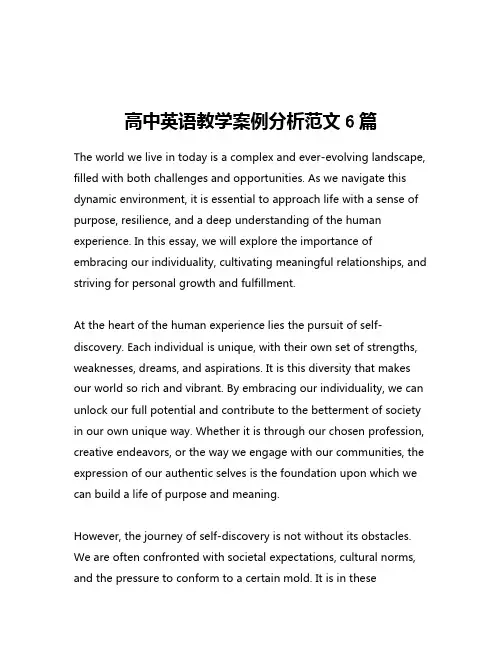
高中英语教学案例分析范文6篇The world we live in today is a complex and ever-evolving landscape, filled with both challenges and opportunities. As we navigate this dynamic environment, it is essential to approach life with a sense of purpose, resilience, and a deep understanding of the human experience. In this essay, we will explore the importance of embracing our individuality, cultivating meaningful relationships, and striving for personal growth and fulfillment.At the heart of the human experience lies the pursuit of self-discovery. Each individual is unique, with their own set of strengths, weaknesses, dreams, and aspirations. It is this diversity that makes our world so rich and vibrant. By embracing our individuality, we can unlock our full potential and contribute to the betterment of society in our own unique way. Whether it is through our chosen profession, creative endeavors, or the way we engage with our communities, the expression of our authentic selves is the foundation upon which we can build a life of purpose and meaning.However, the journey of self-discovery is not without its obstacles. We are often confronted with societal expectations, cultural norms, and the pressure to conform to a certain mold. It is in thesemoments that we must have the courage to challenge the status quo and forge our own path. By cultivating self-awareness and a deep understanding of our values, we can navigate these challenges with grace and resilience, ultimately emerging as stronger and more empowered individuals.Alongside the pursuit of self-discovery, the cultivation of meaningful relationships is a vital aspect of the human experience. We are inherently social creatures, and our connections with others profoundly shape our lives. Whether it is the love and support we receive from family and friends, the mentorship and guidance we find in our communities, or the deep bonds we form with romantic partners, these relationships are the bedrock upon which we build our lives.In an increasingly interconnected world, it is easy to become consumed by the superficial connections we make through social media and digital platforms. However, true fulfillment comes from the depth and quality of our relationships, not their quantity. By investing time and energy into building genuine, authentic connections with others, we can create a support system that nurtures our personal growth, provides a sense of belonging, and helps us navigate the ups and downs of life.Moreover, the cultivation of meaningful relationships extendsbeyond our personal lives and into the broader societal context. As we engage with our communities, whether it is through volunteering, political activism, or simply being a good neighbor, we have the power to contribute to the greater good and foster a more just, equitable, and compassionate world. By recognizing our interconnectedness and our shared responsibility to one another, we can work towards creating a society that values empathy, collaboration, and the collective well-being of all its members.Finally, the pursuit of personal growth and fulfillment is a lifelong journey that requires a deep commitment to self-improvement and a willingness to step outside of our comfort zones. In a world that is constantly evolving, it is crucial that we remain adaptable, open-minded, and eager to learn. Whether it is through formal education, self-directed learning, or the acquisition of new skills, the pursuit of knowledge and personal development is the key to unlocking our full potential and staying relevant in an ever-changing landscape.However, personal growth is not just about the accumulation of knowledge and skills; it is also about the cultivation of emotional intelligence, empathy, and a deep understanding of the human condition. By cultivating these qualities, we can develop a greater sense of self-awareness, emotional resilience, and the ability to navigate the complexities of life with grace and wisdom.As we strive for personal growth and fulfillment, it is important to remember that the journey is not always linear or easy. We will inevitably face setbacks, challenges, and moments of uncertainty. It is in these moments that we must draw upon our inner strength, our support systems, and our commitment to growth and self-improvement. By embracing these challenges with a positive mindset and a willingness to learn, we can transform them into opportunities for personal growth and transformation.In conclusion, the human experience is a rich and multifaceted tapestry, woven with the threads of self-discovery, meaningful relationships, and personal growth. By embracing our individuality, cultivating genuine connections with others, and continuously striving for self-improvement, we can unlock our full potential and contribute to the creation of a more just, equitable, and compassionate world. As we navigate the complexities of life, let us approach each day with a sense of purpose, resilience, and a deep appreciation for the beauty and wonder of the human experience.。
高中英语精选教学设计案例
高中英语精选教学设计案例一、单元主题:人与自然1. 教学目标:a. 提高学生的听、说、读、写能力;b. 培养学生的自主学习和合作学习能力;c. 增强学生对自然环境保护的意识。
2. 教学内容:a. 文化背景介绍:自然灾害与环境保护;b. 学科知识点:自然灾害的类型与原因、环境保护的重要性;c. 语言技能训练:听力、口语、阅读、写作。
3. 教学活动:活动一:听力训练a. 听取不同类型的自然灾害新闻报道,学生进行听力填空练习;b. 听取环境保护相关的演讲稿,学生进行听力理解和问题回答。
活动二:口语训练a. 小组讨论:学生分组就自己所在地区的自然灾害进行讨论,包括原因、对人们生活的影响以及如何应对;b. 角色扮演:学生分角色模拟对话,讨论环境保护的重要性。
活动三:阅读训练a. 阅读文章:学生阅读与自然灾害及环境保护相关的短文,并进行问题回答;b. 阅读广告:学生阅读关于环境保护的广告语,并进行理解和判断。
活动四:写作训练a. 写作任务:学生写一篇关于自己对环境保护的看法和建议的短文;b. 互评批改:学生交换作文进行互相批改,提供改进意见。
4. 教学评价:a. 听力训练:根据填空练习的正确率进行评价;b. 口语训练:根据小组讨论和角色扮演的表现进行评价;c. 阅读训练:根据问题回答和理解判断的准确度进行评价;d. 写作训练:根据语法和表达的准确性、连贯性进行评价。
5. 教学延伸:a. 建议学生在课下深入了解自己所在地区的自然灾害和环境保护情况,并将其整理为报告;b. 鼓励学生自主进行英语环保演讲比赛。
二、单元主题:文化交流1. 教学目标:a. 培养学生的跨文化交际能力;b. 提高学生的阅读和写作能力;c. 增强学生对不同文化的理解和尊重。
2. 教学内容:a. 文化背景介绍:不同国家的传统节日和习俗;b. 学科知识点:节日及习俗的由来和意义;c. 语言技能训练:阅读、写作和口语。
3. 教学活动:活动一:阅读训练a. 阅读:学生阅读不同国家的传统节日和习俗的相关文章,并进行问题回答和讨论;b. 阅读广告:学生阅读关于节日庆典活动的广告,并进行理解和判断。
高中英语教学设计案例5篇
高中英语教学设计案例5篇高中生要作好充分思想准备,以自信、宽容的心态,尽快融入集体,适应新同学、适应新校园环境、适应与初中迥异的纪律制度。
记住:是你主动地适应环境,而不是环境适应你。
因为你走向社会参加工作也得适应社会。
接下来是关于高中英语教学设计案例的文章,希望能帮助到大家!高中英语教学设计案例1Teaching Aims and DemandsWords and PhrasesFour Skills: stomach fever ought ought to examine plenty plenty of diet keep up with make a right choice short of fit gain now and thenThree Skills: energy soft bar fuel chemical balance tasty boil mixtureSpoken English:In the clinic / seeing a doctor:What’s wrong with you?/What’s the matter with you?Lie down and let me examine you.Let me have a look.Where does it hurt?Drink plenty of water and get some rest.I’ve got a pain here. This place hurts.There’s something wrong with back/my kn ee/my arm.I don’t feel well.Grammar:Use of Language:1. Master the function use of language as defined above.2. Help the students to finish the tasks of listening, reading, writing, speaking presented in the book and the exercise bookthrough using what the students have learned.Learn the text about healthy eating. Get the students know about the basic knowledge of how to eat healthily.Important points:1. Talk about different kinds of food that one favorites.2. learn the basic knowledge of healthy eating.3. learn how to say in the clinic.4. Grasp the language points and grammar in the text.Difficult points: The use of modal verbs --- had better, should and ought to.Teaching aids: computer or slider-projectorWay of Teaching: Communication way of teaching, discussion and group work.Lesson 1Step 1 Warming-UpFirst show the students some pictures of dishes and so to introduce the topic of this unit.And then show the pictures on their text books and let them to decide what is junk food and what is not.Here the students may have a short ask and answer in pairs to themselves more engaged in the topic.Step 2 ListeningLet the students listen to the tape and be prepared to answer the questions below.Step 3 SpeakingShow the students the three situations as on P2. Then ask the students to prepared a dialogue according to the examples in pairs. Ask several pairs of students to present their dialogue After that list the useful expressions in their dialogue.Step 4 HomeworkPrepare for the next class.Collect some menus if possible for the next class.Lesson 2Step 1 IntroductionUsing the questions on P3 to introduce the new text.Step 2 Fast-reading1.What does the “fuel ” mean in the first paragraph?(It means different kinds of materials, such as protein, Calcium that we need to keep healthy.)2.What do we have to consider when we choose to buy or eat?(What kinds of nutrients that the food contain.)3.What made our eating habit changing?(Many things: what people believe, advice from companies and stores.)4. How can we feel and look fine?(We ought to learn about our body and the fuel it needs to keep fit.)Explain the language points if necessary.Step 3 Carefully-readingHow many parts can be divided into?(Three parts.)What’s the main idea of each part?(1.our eating habits are changing. 2.why the eating habits are changing 3.the best way to develop healthy eating habits.) Step 4 TalkingAsk the students to take out their menus and read them carefully. Then prepare a dialogue that may happen between a customer and a waiter/waitress.Step 5 HomeworkFinish the exercise --- Vocabulary on P5. and P72-73Lesson 3Step 1 RevisionCheck the homework.Step 2 GrammarFirst present the students the modal sentences with Modal Verbs and ask the students to make some sentences with them.Step 3 Consolidation(1) Finish the exercise on P5 and on P74(2)Take out a piece of paper with the column “Ask ###” in order to make the students understand when you are giving advice it is better to use some sentences with had better (not), and ought(not) to, should(not). Then read a passage as an example and afterwards list the points you have to pay attention to when you give advice.1.give advice that will really help the person.2. be polite and sincereat last get the students to finish the following practice.Step 4 HomeworkFinish the exercise 3 on P74 in the students’ workbook.Lesson 4Step 1 RevisionLet some students read their reply to the letters on P74.Step 2 ReadingRead the text on P6 and then get the students to find the main idea of it (Snacks is also important . we need to learn something about snacks and the way to prepare it.)Step 3 WritingAsk the students to work in pairs to write the recipe for their favourite dish.We may first give the tips on P7 as a guide.Step 4 DiscussionFirst ask the students to read the passage on P75 and then give the following questions as the topic for the students to talk: What is a couch potato?What does one have to pay special attention to in order to keep healthy? (food and exercise etc.)Step 5 HomeworkDo a general survey in order to learn about the differences between people’s eating habits and try to find which is healthier.高中英语教学设计案例2Teaching aims and demands:a. Achieve language skills and related knowledge about the topic of friends and friendship;b. Learn to express likes and dislikes and make apologies:c. Vocabulary in this unit:the words and expressions listed on the teacher’s bookd. Grammar:Direct and indirect speechLesson 1Step 1 Presentation and discussion (warm-up)Put some new words on the blackboard and tell them something about a friend.Kind honest brave loyal happy wise strongbeautiful handsome rich smart funnyThen ask some questions around the class and discuss with them.What should a good friend be like?What qualities should a good friend have?Should they be funny, smart and strong?Step 2 ReadingAsk the students to read the dialogue in the part SPEAKING. Ask some questions:1.What doesn’t John like?2.What does Joe think of music and skiing?And then fill in the form on page 3.Then ask the students to express their ideas freely. Encourage the students to say more about friends.Step 3ListeningAsk the students to listen to the tape and fill in the blanks in the listening part.Step 4 Talking/PracticeAsk the students to page 85. Make a similar dialogue as in exercise 2.Some useful expressions :Why did you…? Why didn’t you…? You said that you would…Please forgive me. You promised to … I’m very sorry… It won’t happen again. I forgot.Step 5 HomeworkFinish Exercise 3 in the workbook.Lesson2Step1 RevisionAsk several students to present a speech about friends as a revision.Step 2 Pre-readingPresent the students a picture to illustrate the situation on a lonely island. Ask them to list three items in the box and ask them to give the reasons using the sentences listed on page3.Step 3 ReadingBefore asking the students to read the text, first give the students a brief introduction about Tom Hanks, his films and the film Cast Away.Then students read the text, and answer the following questions.1.How does Chuck Noland come to a deserted island?2. In order to survive on the island alone, what does he need to learn?3. What does he understand at last?4. For us, what lesson we can learn from Chuck?At the same time explain the language points if necessary.Step 4 Post-readingDiscuss the following questions in the Part POST-READING.Step 5 HomeworkPrepare a talk about Tom Hanks or something about one of his film.Lesson3Step 1 RevisionGet the students to give a talk about Tom Hanks or something about one of his films.Step 2 Language StudyAsk the students fill in the blanks with proper words.Step 3 GrammarIllustrate to the students the use of Direct and Indirect Speech.Then ask the students to do the exercise in the Part Grammar on P5.Step 4 PracticeAsk the students to act the exercise2 in the part Grammar out.Step 5 HomeworkAsk the students to finish the exercise2 in their workbook.Lesson4Step 1 RevisionCheck the homework.Step 2 PresentationPresent simples of e-mail to get the students a general idea of e-mail.Step 3 ExplanationTell the students some tips of writing an e-mail by learn the above e-mail simple.Step 4 WritingAsk the students to write an e-mail message.Step 5 HomeworkAsk the students to try to write an e-mail to their e-pal.高中英语教学设计案例3Ⅰ. Teaching Basis (教学依据) :《普通高中英语新课程标准》Ⅱ. The Type of the Text (课型) :Revision (复习课)Ⅲ. Teaching Methods(教学方法): Question-based method(提问式),Group discussionmethod(小组讨论法),Cooperative learning(合作探究),Practicing(练习).Ⅳ. Teaching Aids (教学手段) :Multimedia computer(多媒体电脑),Learningpaper(导学案),Blackboard(黑板).Ⅴ. Teaching Aims(教学目标) :①Knowledge aims(知识目标): words: achievement, specialist, organization, hard-working, confident….. phrases: put to death, mean doing, either…or…, the bond between……, structure: only+…., It is/was+….+that…. grammar: Subject-verb agreement.②Ability aims(能力目标): Develop the students’ ability to use the importantlanguage points, enable students to describe people using the adjectives.③Emotional aims(情感目标): Encourage the students to think about what makes aperson great.Ⅵ. Teaching focuses(教学重点):Get the students to review and consolidate what theyhave learned in this unit.Ⅶ. Teaching difficulties(教学难点):Get the students to turn what they have learned intotheir ability.Ⅷ.Teaching procedure(教学过程): Step 1 复习学案情况反馈(1分钟)Step 2 lead-in :通过图片展示的方式,过渡到知识竞答类节目《一站到底》,本节课也将模仿这种模式授课。
高二英语教学实践案例(3篇)
第1篇一、案例背景随着新课程改革的不断深入,英语教学越来越注重培养学生的综合语言运用能力。
在高中英语阅读教学中,教师不仅要传授给学生阅读技巧,还要培养学生的阅读兴趣,提高他们的阅读能力。
本文以高二英语阅读课为例,探讨基于任务型教学法的高中英语阅读课教学实践。
二、教学目标1. 知识目标:掌握一定的阅读技巧,如略读、寻读、精读等。
2. 能力目标:提高阅读速度和理解能力,学会从文章中获取信息,培养批判性思维能力。
3. 情感目标:激发学生的阅读兴趣,培养学生的自主学习能力,增强学生的自信心。
三、教学对象高二年级学生,具备一定的英语基础,但阅读能力参差不齐。
四、教学过程(一)导入1. 话题导入:教师选择与课文主题相关的图片、视频或话题,激发学生的兴趣。
2. 提问导入:教师提出与课文主题相关的问题,引导学生思考。
(二)任务一:快速阅读1. 目标:了解文章大意,掌握文章结构。
2. 方法:教师引导学生进行快速阅读,了解文章的主题、作者观点、主要事实等。
3. 活动:教师可以设计以下活动:快速浏览文章,回答问题。
找出文章的主旨句。
划分文章段落,概括段落大意。
(三)任务二:精读1. 目标:深入理解文章内容,掌握文章细节。
2. 方法:教师引导学生进行精读,分析文章的语言特点、写作手法等。
3. 活动:词语理解:找出文章中的生词,查找词典或利用上下文推断词义。
句子分析:分析句子的结构、语法、修辞手法等。
举例说明:举例说明文章中的观点或事实。
(四)任务三:讨论与表达1. 目标:提高学生的口语表达能力,培养他们的批判性思维能力。
2. 方法:教师引导学生进行小组讨论或全班讨论,表达自己的观点。
3. 活动:小组讨论:围绕文章主题进行讨论,分享自己的观点。
全班讨论:全班同学共同讨论,教师引导并总结。
(五)任务四:拓展与延伸1. 目标:提高学生的综合语言运用能力,拓宽他们的知识面。
2. 方法:教师引导学生进行拓展阅读或实践活动。
3. 活动:拓展阅读:推荐与课文主题相关的书籍或文章,引导学生进行阅读。
高中英语优秀教学案例六篇
高中英语优秀教学案例六篇英语教学案例1一、教学目标1.能够听懂、会说几个重要节日的词汇,并能用英语表达这些节日所在的月份。
2.能够以图文并茂的形式介绍自己喜欢的某个节日。
3.欣赏并学唱关于月份的歌曲。
二、教学建议A. Good to know.1.热身与复习(1)复习12个月份的英文表达①教师引导学生认读月份名称的单词卡片,随即发给读词最快的学生。
②拿到词卡的学生一起站到教室前面,按月份的顺序排队。
③全班再次按顺序说出12个月份的英文表达。
(2)教师呈现年历或第一课时歌谣课件,引导学生演唱第一课时所学的歌谣。
(3)师生交流:When is your birthday? It‘s in ...2.学习新知(1)教师呈现母亲节图片,引导学生观察画面内容,如:Who are they? What is the girl doing? Why is she giving flowers to her mother? Is it her mother’s birthday?...引出Mother‘s Day之后,让学生跟读词汇。
英语教学案例2一、语言技能目标第一层次:1.能够听懂、会说衣服词汇cap,coat,shoes,sweater,jacket,gloves,trousers;能在四线三格中基本规范地抄写单词,并尝试借助拼读规律记忆单词。
2.能够听懂、会说用来介绍复数衣服的功能句:These are ...3.能够听懂、会说用来询问自己该穿什么衣服的功能句:What should I wear today?及其答语:You should wear ...,初步学会在恰当的情境中运用,并通过描摹句子来体会句子书写规范,为抄写句子和独立写句子打基础。
4.能够读懂介绍自己所在城市的季节、天气、穿衣情况以及询问对方城市相关情况的小书信;并通过替换小书信中的关键信息回信,介绍自己的上述情况,回复朋友的询问。
5.能够借助熟悉的旧单词和图片感知字母u在闭音节单词中的发音规律,并利用该规律拼出新单词的读音,进而尝试记住其写法。
- 1、下载文档前请自行甄别文档内容的完整性,平台不提供额外的编辑、内容补充、找答案等附加服务。
- 2、"仅部分预览"的文档,不可在线预览部分如存在完整性等问题,可反馈申请退款(可完整预览的文档不适用该条件!)。
- 3、如文档侵犯您的权益,请联系客服反馈,我们会尽快为您处理(人工客服工作时间:9:00-18:30)。
高中英语教学案例--人教版选修9(高三选修九第一单元Breaking the record 第二课时阅读课)引言在英语教学中落实新课程标准,就是贯彻执行国家教育部关于课程改革的决定。
新课程标准的三维教学观,具体到英语学科就是要整合发展学生语言技能、语言知识、情感态度、学习策略和文化意识五个方面的素养,培养学生综合运用语言的能力探究学习、合作学习、任务型学习是在新课程标准下实施素质教育的关键环节,所以在我的教学设计里,时时体现着这几种原则。
教学设计理念1、运用任务型语言教学模式,训练培养学生对语言的综合运用,实现目标,感受成功,教学进度整体把握,教学形式不拘一格。
2、课堂以学生为主体,以任务为主线,重视体验参与,教师起到“设计者、研究者、促进者、协调者”的作用。
3、在教学中,突出交际性,注重读写的实用性,要进行情感和策略调整,以形成积极的学习态度,促进语言实际运用能力的提高。
4、课后访谈调查,读写摘记,重视语言运用。
5、正视个体差异,倡导过程激励,以多层次、多角度、多主体的结果与过程并重的评价方式激励进步。
一、学情分析一方面,高中年龄段的学生对周围的事物较为敏感,有自己的观点和看法,他们不满足于教科书上的知识,想获得更多的信息。
在英语学习上,他们不只是想把英语作为一门死记硬背的课程来学,更希望能学到知识性和趣味性兼有的内容,从英语学习中获得更多的知识和能力。
另一方面学生对体育比较感兴趣,对吉尼斯纪录有一定的了解因此,应结合学生的实际情况,因材施教,激发学生兴趣,让学生主动学习,学有所获。
二、教学内容分析(一)知识背景及新课程、新教材本单元以世界纪录为中心话题,只要内容涉及以阿里西塔福尔曼为代表的几个世界吉尼斯纪录的保持者及其运动经历,重点讨论了创造吉尼斯纪录所必备的身体素质心理素质创新意思以及挑战自我的决心和毅力语言和技能都是围绕这一中心展开的。
本课是是本单元第二课——“阅读课”,于是本单元的重点。
文章的主题是“路永在前方”其内容介绍了世界吉尼斯的保持者阿西里塔福尔曼,他不是职业运动员,但其运动成就让许多运动员望尘莫及,本课通过阿里西塔福尔曼的成长经历以及获得这些成就的精神动力激励学生认识自我的潜力找到精神动力的源泉,实现梦想。
(二)教学重点难点(1)重点:1.了解记叙文的文体特点并以此指导阅读;训练skimming, scanning, careful reading等阅读微技能;3.对文章深层次的理解及细节的欣赏,认识及分析主人公的人物特征及人物性格。
(2)难点:1。
阅读技能的训练;2.对记叙文的鉴赏能力及人物评价。
(确立依据:阅读在整个英语教育体系和高考中都占有重要比例,阅读能力的提高不是一朝一夕事。
再高明的老师也不可能把自己的阅读能力传授给学生。
学生阅读能力的提高只能在老师的指导下通过实践训练获得。
复述课文是检查学生对课文的理解程度,同时又是提高学生口语能力的重要方法)三、三维教学目标(一)知识技能①通过本课的学习使学生能够在理解的基础上复述课文②在阅读中体会并初步掌握生词、词组句型的用法③体会作者在写本文时是如何进行内容安排的(二)情感态度①了解吉尼斯纪录的相关知识、以及勇于挑战并打破纪录的杰出人物应具备的品质②鼓励学生打破“我不行”的心理暗示让意念统领身体走出一条完美的道路(三)学习策略(能力目标)1.认知策略:①通过词族和词缀的学习让学生掌握一种记忆单词的方法,②通过三读法让学生掌握速读、跳读、精读的要领2.调控策略:通过阅读让学生了解到阅读过程中与很多阅读障碍,不可求全责备,调整心态和注意力,通过读懂细节,推断隐含内容,要掌握大意。
获取所需信息。
依据:在新课程理念要求老师传授给学生阅读方法,读阅读进行整体教学,而不在局限于单词句型的传统教授。
在学生现实阅读当中很多学生过分地方注意力放在生词上面,而不注意阅读方法的培养,反映在考试中为遇到一片生词较多的语篇就丧失了阅读的信心。
3.交际策略:通过谈论体育项目、埃西里塔福尔曼等真实交际活动提高用英语交际的能力。
4.资源策略:让学生了解网络图书馆和书籍资料一样是学习的重要途径。
(四)文化意识:了解吉尼斯的相关知识,加深对吉尼斯纪录的了解(教学目标的确立依据:本课是阅读课,课文是对话,阅读是英语教学的重点,也算是难点,同时根据英语标对学生能力的要求,本课教学以阅读教学为主,同时兼顾听说能力的培养,另外根据本单元的内容和特点把德育教育渗透到教学当中去)四、教法分析教学方法:问答法(question and answer) 讨论法discussion 辩论法(debate)taks-based method(任务教学法)教具教学手段:①Multi-media computer; OHP(overhead projector); tape recorder; PowerPoint②多媒体辅助教学(依据:根据本课特点以教材为本,传统教学手段和现代多媒体教学手段相结合,恰当合理呈现本课内容。
)五、学法指导阅读是一种积极主动地吸收、思考、理解、接受信息和反馈信息的过程,也是一种复杂的智力活动。
培养学生的阅读理解能力可分三个层次:表层理解、深层理解和评价性理解。
表层理解是培养学生对文章表面信息的把握;深层理解是引导学生通过联想、推理、归纳等思维活动对文章主题或某一章节进行进一步的理解;而评价性理解建立在从整体角度对课文深层理解的基础上,旨在引导学生联系社会实际或自身生活,对某一相关话题进行讨论,使学生进行发散性、创造性思维。
通过一学期的阅读教学,学生已初步建立了阅读的基本技能—Skimming(略读)和Scanning(查读),教师引导学生结合语境,采用推测、查阅或询问等方法进行学习。
六、具体教学步骤(Teaching procedures:)教学过程流程图Leading-in(导入) 激趣Pre-reading(读前) 任务一铺垫任务二表层理解While reading(读中) 任务三表层理解任务四深层理解Post reading (读后) 任务五评价性理解Summary &homework(总结与作业) 任务六阅读的延伸综合运用语言的能力文化意识策略Leading-in (discussion)To show Ss pictures about some famous athletes to let them know something in common about these people--the key of success.Some words may be used in this activity :Sports champion athlete winning breaking records challenge exciting confidence physical ability speed strengthSomething in common:concentration confidence good physical abilities speed strength flexibility athletic skills strong will interest hard training目的及依据:本环节通过看图讨论激发学生的学习兴趣激活已有的背景知识,使学生能运用已有的知识和经验思考本单元的中心话题。
能起到温故而知新的作用。
Pre-readingTask oneto show students some pictures which occur in the text,First, lets them to know the name of the activity and the way to do it,Second, let the students experience one or more of this, such as somersaulting doing jumping jacks,Third, thinking and discussing①Would you consider each activity to be serious sports?②Which activity would you like to try? Would you need to be fit to do any of them?③Do you think you could do any of them for any length of time?(Indication:Different activity requires different physical fitness psychological personification such as coordination strength balance? concentration strong will devotion)Now class we will read a story about a man called Ashrita Furman who has broken Guinness records.(过度)(读前部分设计依据及目的:本部分根据学生的认知规律而设计,首先让学生借助图片了解运动的名称及运动方式,其次,让学生体验其中一项或几项活动,体验后让学生思考问题这种方式有浅入深由感性认识到理性思考了解文章当中提到的运动项目降低阅读难度,为下一步阅读理解做好充分的准备)While readingTask two Listening (scanning)(close your book 此处把快速阅读与听力整合在一起正大课堂容量加快课堂节奏) (提高学生的听力水平培养快速获取所需信息的能力)Task twoListen to the tape, after listening tick the topics that the author does not cover①physical skills needed for events ②number of records broken ③his family life ④kind of records broken ⑤why he became a sportsman ⑥countries he likes best⑦place and date of birth ⑧his occupation ⑨his education ⑩his first Guinness record(目的及依据,新课程理念要求让学生对语篇整体学习,为此首先让学生快速把握文章结构要点让学生从整体明白文)Task threeSkim the text and answer the questions①Who is Ashrita Furman?②When and why he entered the Guinness book of world records?③When did Ashrita become a student Chinmoy?Explain some new words and sentences in the text (解决阅读障碍)Task fourCareful reading first look through the questions①Where do you think Ashrita lives?②How do you know③Has he broken records in all seven continents?④When did he first come across the Guiness book of the world records⑤What are some of his pgysical difficulties?A walking with a bottle of milk on his headB standing on top of a Swiss ballC somersaultingD doing gymnastically correct lunges⑥what happens in an event that prevent Ashrita from giving up?Post readingTask fiveDiscussion on Ashrita’s motivation①Why did Ashrita challenge the Guinness world records instead of taking part in the Olympic games?②Why does he keep on trying to challenge different Guinness records?③Why didn’t he take part in a conventional sports instead of un conventional and funny one?④Why did Ashrita took part in active sports after learned quiet mediation?Task sixdiscussion on Ashrita’s belief.work in group four or five each group may be for it or against it, choose one, and discuss with your group, (divide the class into two parts for-part and against part, then have aclass report)Task sevenSummary and homeworkTask oneWrite an article about the imagination about the outlook of AshritaTask twowork in group to find more information about Ashria through internet as well as books about after class each group should try brief paper about ahsrita.七、教学时间分配教育心理学指出新知识的学习需要一个接受的过程。
